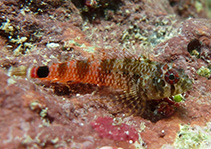| Diagnosis: |
Dorsal spines (total): 10-10; Dorsal soft rays (total): 7-7; Anal spines: 2-2; Anal soft rays: 15-15. This species is distinguished by the following characters: dark orbital cirrus, relatively broad, ending in a broad flat end or one to several shallow points; with 2-10 usually ctenoid scales on upper preopercle immediately behind eye, below sensory canal (in individuals over 1.8 cm SL); with a row of 4–9 intense dark, rounded spots along pored lateral-line, centered on dark body bars; the iris with six wide, red, spoke-like bands with much narrower interspaces (when live or fresh), spoke at 2 o’clock notably narrower than others; short snout with a broad dark band from orbit across front half of upper and lower jaws; the prominent dark bar curving from lower rim of orbit usually past corner of jaws and followed behind by a broad light bar, often with a central dark patch; dark dorsal head, preopercle and opercle; the rear body is bright red to red-orange, especially ventrally; anal fin is usually uniformly pigmented, but sometimes barred with reddish or dusky bands slanting forward from base; the caudal-peduncle dark bar is typically ovoid (wider at center with corners rounded) and usually narrower in width than height, ending at base of caudal-fin rays, followed on caudal fin by a narrow “accent” bar, red and/or dark, and then, after a narrow pale (white in life) band, a broad dark tail band often interrupted with a pale circle top and bottom (lower is larger), then a narrow pale (white in life) band at rear margin (Ref. 116142). Characters shared with Enneanectes quadra: D III+XII+7, with the first dorsal fin short, not reaching second-spine base of second dorsal fin (often barely reaching fin origin) when adpressed; A II,15; pectoral-fin rays 15; usually 13 pored lateral-line scales and about 19 or 20 scales in notched midline row; belly and pectoral-fin base scaled and with 2 scales above rear of pored lateral-line, upper scale much smaller [both characters of scaled-belly subgroup]; body bars 5 with last bar on caudal peduncle much darker; anterior orbital flange with fine spines (Ref. 116142). |
